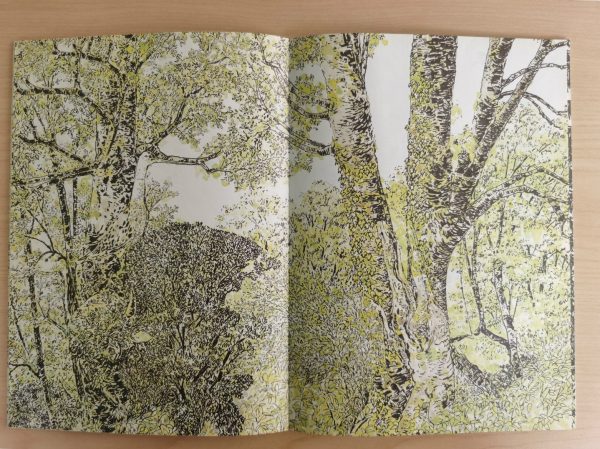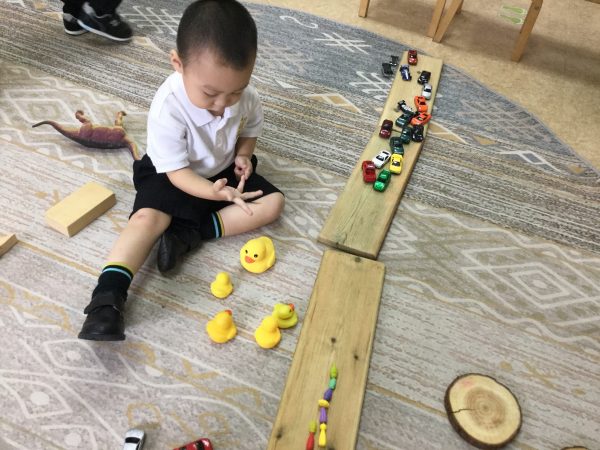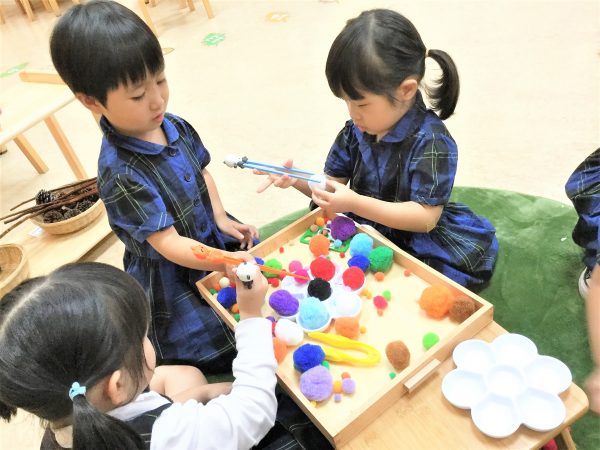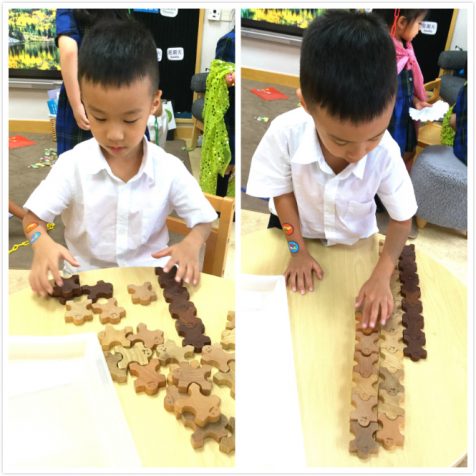
Parents often ask me "How do Huili nursery’s teachers measure their children's development? How do they support their education?" Before answering these questions, however, I would like to share a story. A parent once asked me look at a book for him, because he did not know how to read it to his child. The book was Forest by Japanese illustrator and writer Anno Mitsumasa. 
It's a popular picture book with our pupils, but the parent was confused, because it had not words, only illustrations of trees and bushes. I told him, "Why not try look at the pages from a distance? It may help you to see the pictures as a whole, rather than focusing on the minute details.” He took this advice, and he immediately discovered a toucan, a wild boar, a crocodile snipe and many more animals. The point to my story is this: Sometimes you just need to take a few steps back and observe to see what is actually going on in the picture. Observation is what we do in the classroom. Below are several observations from our teachers that I believe illustrate the many ways in which we support learning and measure development at Huili Nursery Shanghai.
EY1

Our EY1 teacher observed the actions of a pupil engaged in play, noting that the pupil likes singing in the classroom and moves his hands to the rhythm, counting with his fingers, chanting "one, two, three, four, five…" The diary goes on to describe how the pupil "placed a caterpillar he made from beads on a toy bridge to help it cross a river." After some observation, the teacher asked the pupil, "Why did you put these ducklings here?" "Because they are swimming," the pupil replied. "Where are they going?" the teacher asked.Smiling, he replied, "They are going home with the caterpillar." In addition to diary entries, our teachers take notes on pupils’ key development indicators as demonstrated through play. Here are some examples: • Imitating adult behaviours and joining in symbolic play with the help of others (personal, social and emotional development — building relationships). • Representing numbers with ideas or marks during play (mathematics — numbers). • Play by lining up, placing, arranging and repositioning materials. Categorising objects according to properties such as shape, size or colour (mathematics — shape, space and measurement). • Enjoying rhythm and demonstrating listening by trying to join in with action or vocalisation (communication and language — listening and attention). • Beginning to understand 'who, what and where' questions (communication and language — comprehension). This is the 'connecting' and 'positioning' type of schematic play demonstrated by connecting and lining up items.
EY2

An EY2 teacher recorded in her diary several girls playing together. They used chopsticks and tongs to pick up pom-poms and place them on a plate. One girl asked another, “Do you want to eat some ice cream? There are so many flavours available here. I like the flavour of this red one.” One of her peers replied: “I like chocolate. What flavour is the red one?” “Watermelon," the girl replied, "Mummy said I can eat two scoops of ice cream today." The other girl smiled and replied as she picked up the red pom-pom, “Great! I will buy you another one.” The key indicators this teacher observed were as follows: • Playing in groups, extending and elaborating play ideas by responding to what others are saying or doing (personal, social and emotional development — building relationships). • Awareness of the preferences, needs and interests of others and that they may be different from their own (personal, social and emotional development — self-confidence and self-awareness). • Ability to use one-handed tools and equipment with increasing accuracy (physical development — fine motor skills). Showing preference for their dominant hands (physical development — fine motor skills). • Ability to use mathematical vocabulary to describe shape, size, mass and capacity while engaged in play (mathematics — shape, space and measure). • Choosing particular tools for a specific purpose (expressive arts and design — exploring and using media and materials).
EY3

In EY3’s observation diary, our teacher recorded how a pupil approached her with some wooden figurines and said, “Hi teacher, I need 20 of these to make a ladder, but I do not know if I have enough." The teacher replied, “You can count them first. Then we can figure it out together if you need more.” The boy found more wooden figurines and mixed them all together. He observed them for a while before telling the teacher, "These come in different colours. I think I will count them separately.” After classifying them into two categories based on colour, the pupil observed, "There are more light-coloured ones than darker ones." The teacher asked, "Do you know how to find out how many more there are?" The pupil began counting them, and before he was halfway through, his face brightened up. “I have a good idea!" He said. "I can match the lighter ones to the darker ones. Then I only need to count the remaining figurines." He eventually declared, "There are 11 more light-coloured figurines than dark ones." Here are some of the key development indicators observed: • Explaining their knowledge and understanding to familiar adults (personal, social and emotional development — building relationships). • Trying new activities and describing preferences and choices (personal, social and emotional development — self-confidence and self-awareness). • Counting actions or objects that cannot be moved (mathematics — numbers). • Using the language of 'fewer or more' when comparing two sets of objects (mathematics — numbers). • Confidently solving mathematical problems during play (mathematics — numbers). • Sorting and classifying familiar objects and explaining the basis for these classifications (mathematics — shape, space and measure).
EY4

In EY4’s observation diary, our teacher described the scene of pupils’ group discussion. A boy exhibited great confidence in talking about Huili Values. He first shared his opinions in Chinese about 'courage' with his peers. He said, “Courage means you are able to tell truth. When you find others make a mistake, you must be courageous enough to point it out.” He explained his words to the teacher and wrote down his thoughts on a poster. From this situation, we note the following development indicators: • Showing acceptance of difference and diversity when working together (personal, social and emotional development — building relationships). • Able to speak confidently in large / whole class groups (personal, social and emotional development — self-confidence and self-awareness). • Working collaboratively with others on a task or project and recognising their individual achievements as well those of others (personal, social and emotional development — self-confidence and self-awareness). • Ability to hold paper in position and use their dominant hand for writing. Ability to use a proper pencil grip (physical development — fine motor skills). • Ability to give and explain opinions after hearing factual narratives. (communication and language — comprehension). Describing objects and stories using pictures and symbols (communication and language — reading and writing). According to the photos in the article, you may not see or understand everything a pupil does while at play. But from the perspective of an early years practitioner, this is the learning process in action, and it is profound. It is through this kind of observation that our teachers learn about our pupils’ development and then design personalised holistic learning plans. It is a slow and steady process that requires patience and understanding, but it produces powerful results in our pupils.